Badlands Fieldcraft: Junk On The Bunk: Belt Knife Maintenance
Originally appeared on Badlands Fieldcraft. -NCS
I’m a big fan of carrying a fixed blade knife on my belt out in the bush. I carry it on my belt as part of my line 1 gear, which is my survival and emergency communications equipment, that way I always have it if needed. It’s also one of the first 5 “C’s” of Dave Canterbury’s excellent 10 “C’s” system, being one of the items necessary to maintain your core body temperature in an emergency.
I try to be as consistent as I can be with my line 1 items and their placement. That way, no matter what I’m doing, I always have them with. Putting my “survival” knife on my chest rig does me no good if I don’t carry my chest rig, for instance if I’m carrying my bolt gun. Instead I carry it on my pants belt on my strong side, the same place all year round, regardless of what I’m doing or carrying.
Of course carrying a knife in the bush is not a novel idea, with a fixed blade knife being an essential part of kit for all soldiers, explorers and scouts for centuries. But it’s not enough to just carry the knife, you have to know how to use it and how to take care of it. It might just be one of the most important tools you have.

There are many opinions about what knives to carry and just as many opinions on how to care for them. Compared to other creatures, as humans we have a unique gift in that we can make things infinitely more complicated than they need to be, and knife selection and care is no different. I’d like to detail what works for me. I feel it’s a simple, practical, and inexpensive way to care for a working tool.
I carry the Mora Garberg Carbon on my belt in an ArmorSheaths Kydex sheath. This is a practical and utilitarian setup, with complete focus on function over form.
While I enjoy and appreciate traditional equipment as much as any antique junky or history buff, you have to be practical when selecting your tools. No professional tradesman, whose livelihood depends on the speed that he can get his work done, selects a bit and brace over a cordless drill anymore. If someone does, they are a hobbyist, and hobbies aren’t professions. In other words, pick the right tool for the job.
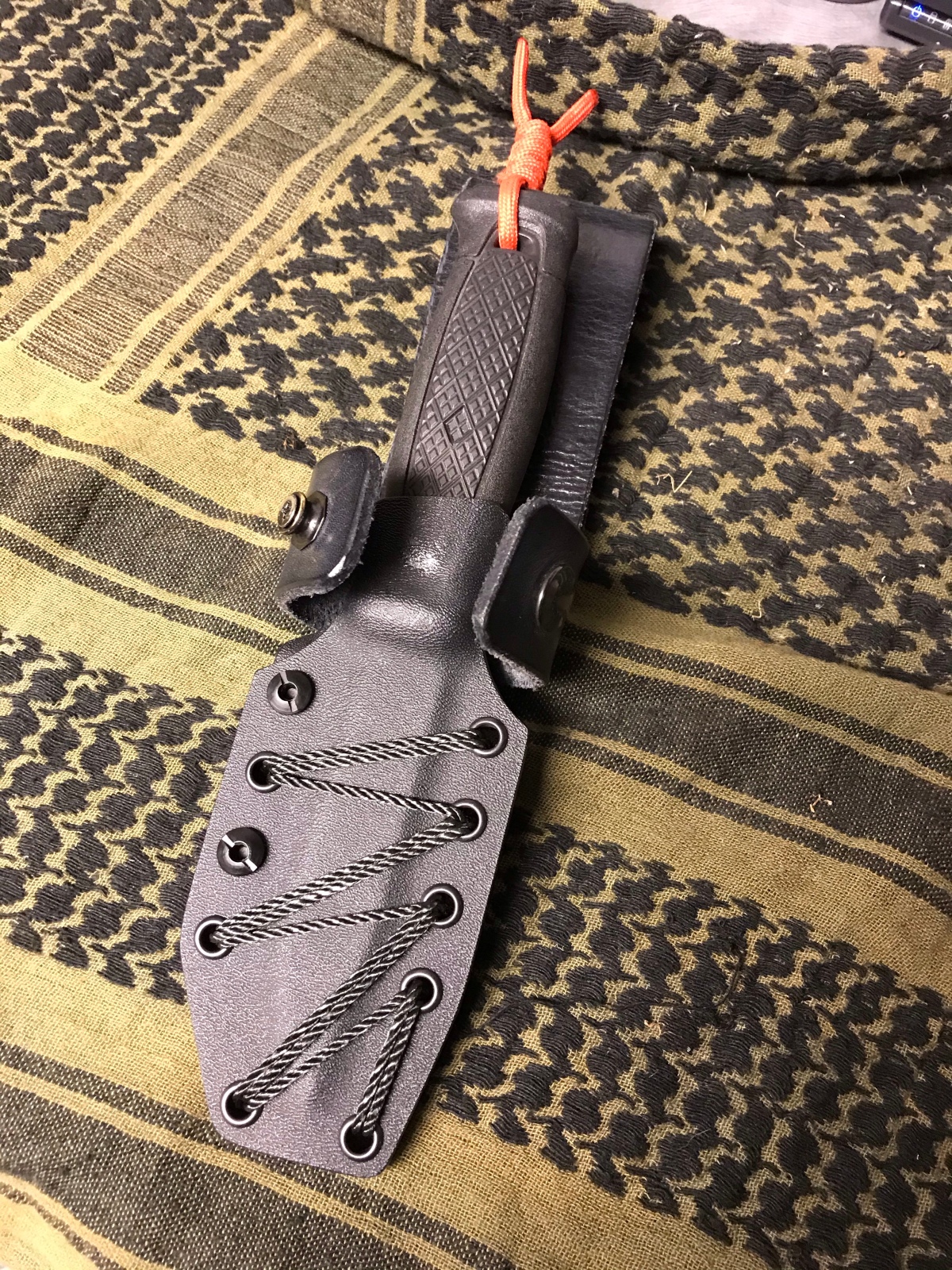
I’m using this particular knife and sheath for a number of reasons to include:
- The knife and sheath combined cost around $150.
- The knife is made by MoraKniv, a very well proven and highly reputable knife maker.
- This model is high carbon steel. Besides being very easy to sharpen, it can be used as a fire steel very well. I demonstrate this in every class.
- The blade is small enough to carry comfortably, but big enough to do everything I need to do with it.
- It’s comfortable to use. I wear medium size mechanix gloves and it fits my hand good, allowing me to put more energy into the work than trying to hold onto the knife.
- Because of its intermediate size, it guts and skins, notches, carves, splits and of course cuts good.
- It retains its edge very good and the Scandinavian grind cuts and carves really well.
- The Kydex sheath is waterproof, not requiring as much care as a leather sheath.
- The Kydex sheath has better and more consistent retention than a leather sheath as well.
- It has (had… with all the use it’s been getting in class I have to reshape this, no big deal) a great 90 degree spine for scraping ferro rods and tinder.
Maintaining the knife
There are only a few areas of concern when it comes to maintaining my knife. These are damage, corrosion, edge sharpness, spine condition and cleanliness. It’s been said that a dull knife will hurt you easier than a sharp knife, since it requires more effort to use. If you use your knife properly, you should never have any issues getting hurt even if it’s shaving sharp.
When I start my maintenance process I start with an inspection. I look for major damage like cracks in the blade or handle. If the blade was improperly heat treated stress cracks will begin to appear in the blade. I also check for chips or rolls in the blades edge. Small chips, say 1mm in width and depth can form under very hard use and can be sharpened out. Bigger chips could be indicative of a bad heat treat. For the record my Mora has yet to produce any chips or rolls.
I’m also looking for serious corrosion that will need serious cleaning. Carbon steel can rust if it doesn’t get occasional oiling. Carbon steel also develops a patina over time, this usually looks like dark grey staining on the metal. This isn’t corrosion and is actually a naturally protective layer for the steel, so there’s no need to remove it, just oil over it. If you do find rust, you can scrub it off with a rag and some oil, or if it’s really stubborn you can scrub it off with a little sand or other mild abrasive.

For oil I prefer natural, edible oils, with coconut oil being my favorite. Coconut oil seems to penetrate and lift dirt and corrosion off the metal better than other oils I’ve used. It also doesn’t gum up like other oils after it’s been on the knife for awhile. And by using something edible, I don’t have to worry about it getting on my food if I use my knife to prepare food.
Edge Sharpness
There’s actually two different processes involved in “sharpening a knife”. The first is “sharpening” which involves using a coarse material like a stone or emery cloth to remove a lot of metal quickly to create an edge. The more coarse the grit, the more metal gets removed per pass.
The second process is called “honing”. Honing is used on a sharpened edge to form the metal to a very keen edge. This is what a leather strop does. It doesn’t remove metal as much as sharpening, instead it polishes and forms the edge.
It is a two part process depending on how dull the knife is you’re starting with. For instance, let’s say you found an old hunting knife at a junk sale that’s been neglected for years and is no sharper than a butter knife. In this case you’re going to want to start sharpening with a low grit stone and work your way up to a high grit stone. This removes chips and the rounded edge, and creates an angle that gets sharper as you go up in grit. After you have gone to your highest grit stone then you’ll want to hone your new edge with a strop. This is where that shaving sharp edge is created.
Once your antique knife has been restored, and assuming it is a quality blade that doesn’t chip easily, you should only have to hone your blade from time to time. As long as you keep it honed and don’t abuse it on rocks or bone, it shouldn’t ever need to see the sharpening stones.
For sharpening I don’t really use anything fancy, no jigs or anything. I just use a Fallkniven DC3 sharpening stone. It’s a two sided stone with a coarse Diamond plate on one side and a finer ceramic stone on the other. It’s small and lightweight and that means it can be packed in with me if I plan on being out long enough to need it.

It also comes with a leather case, with the rough side out on the back. This makes for a convenient strop as well.

There are a few different techniques I use to sharpen depending on what I need to do. If I want to sharpen the whole blade, I lay the stone flat and pull the blade across cutting edge first.

Alternatively, I can hold the stone and run it down the length of the blade if I can’t lay the stone down.

Lastly, if I want to only sharpen a portion of the blade, say to remove a chip, I can hold the stone and work in a circular motion focusing on the area that needs the work. I try to work on both sides evenly and alternate the direction I move the stone as I switch back and forth.
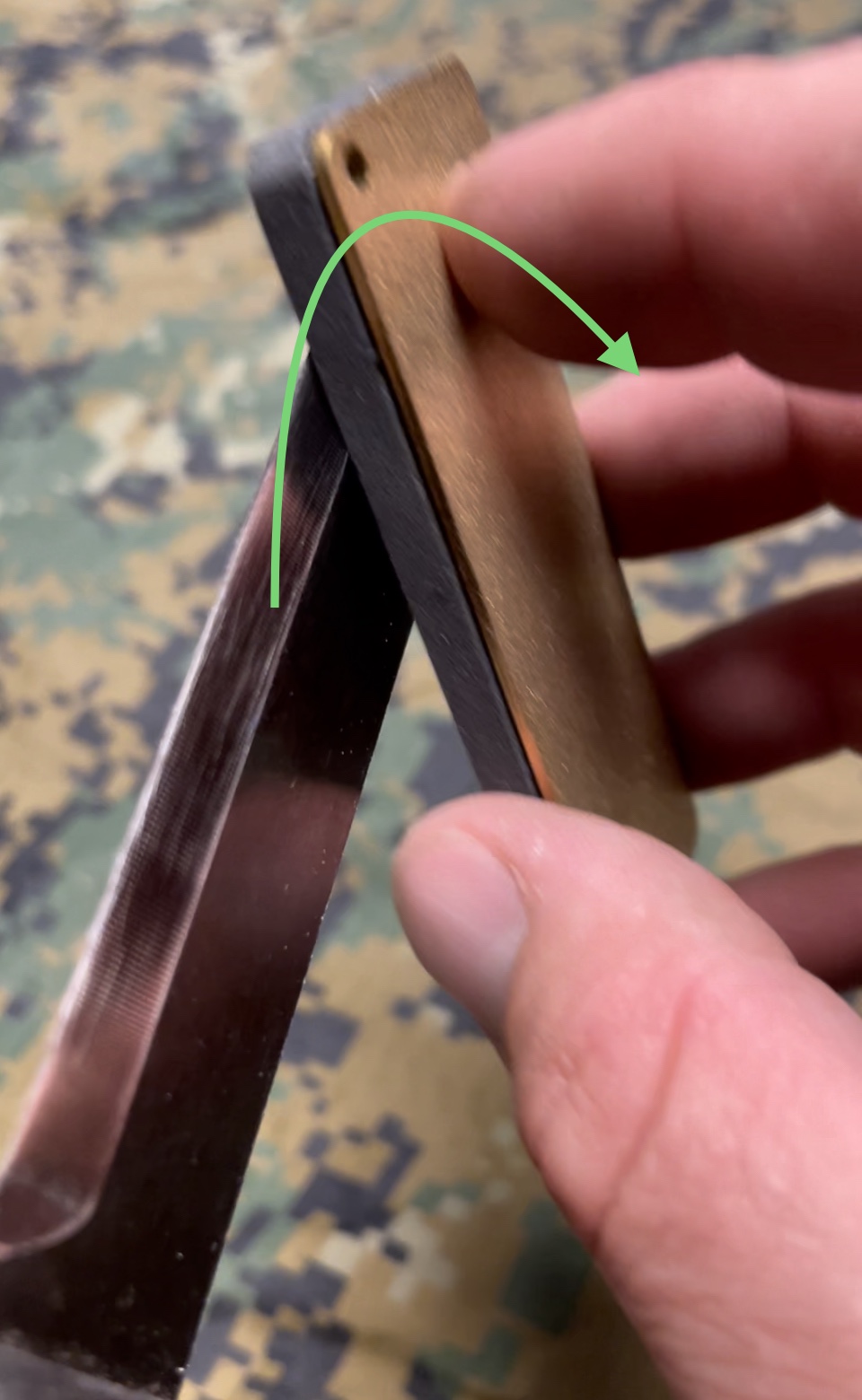
Edge Honing
Once we’ve restored the edge to our blade with sharpening, it’s time to hone the blade. When metal has been sharpened, it creates an edge that if magnified would look very rough. The coarseness of the sharpening stone cuts small grooves in the metal as well as creating a burr on the edge, called a wire edge. The purpose of honing is to smooth these grooves and to shape the wire edge to a very fine point.
I like a small double sided paddle strop when I’m at home, but in the field I use the DC3 case. The paddle strop has a coarse side, with rough out leather, and a smooth side, with the smooth side of the leather facing out.
Starting on the rough side of the strop I add a little green polishing compound, although this does technically remove more metal, it helps the process go quicker. If you’re just getting started one technique that helps ensure you’re making contact properly is to mark the blade with a sharpie. As you strop you’ll be able to keep track of your progress this way.

I lay the blade edge against the leather and pull the blade backwards across it, trying to hit the full length of the blade. I do this 10 times, then I flip the knife over and do it 10 times on the other side. I go back to the first side, and do it nine times, then repeat on the second side. I continue flipping the knife and reducing the number of strokes until I get down to one.
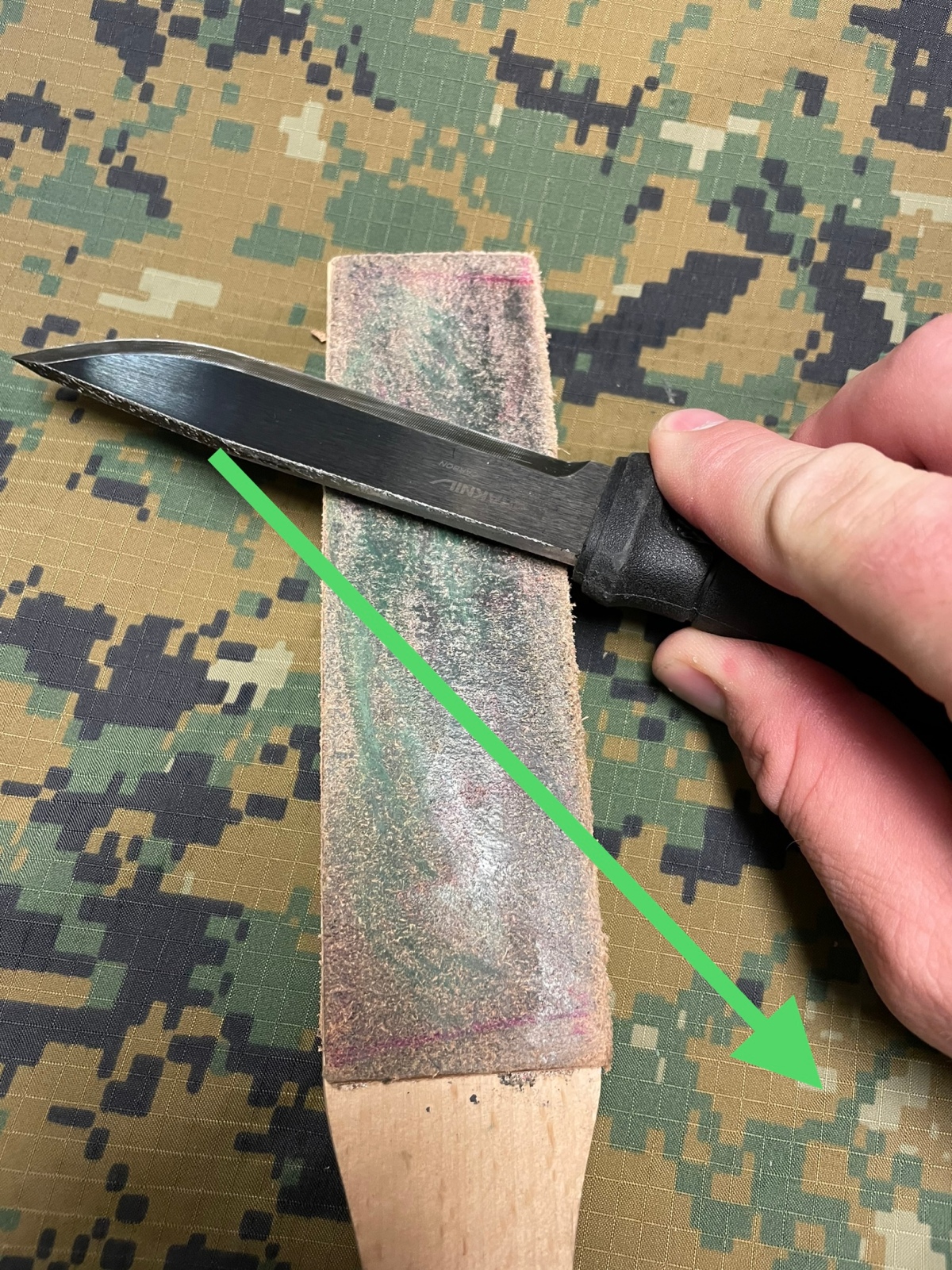

I then switch to the smooth side and repeat the whole process. I like my knife shaving sharp, so at this point I test it on my arm hair. If it’s not where I want it, I repeat the whole stropping process again.
Spine maintanence
For a survival knife, the spine is almost as important as the edge. A proper spine is square shaped, flat and smooth and with well defined corners. This allows for the most surface area when using the knife as a fire steel.
By having well defined corners we can use the spine as a very effective scraper. This can be used to create very fine tinder as well as scraping a Ferro rod very effectively.
If we have jimping or other ornamentation we reduce the amount of steel that can be removed as we are attempting to start a fire. Jimping is also typically located in the best place on the knife for scraping a ferro rod. This reduces the amount of contact the knife has with the rod, therefore reducing the amount of molten material being produced. It can also clog up with debris from scraping to make tinder.
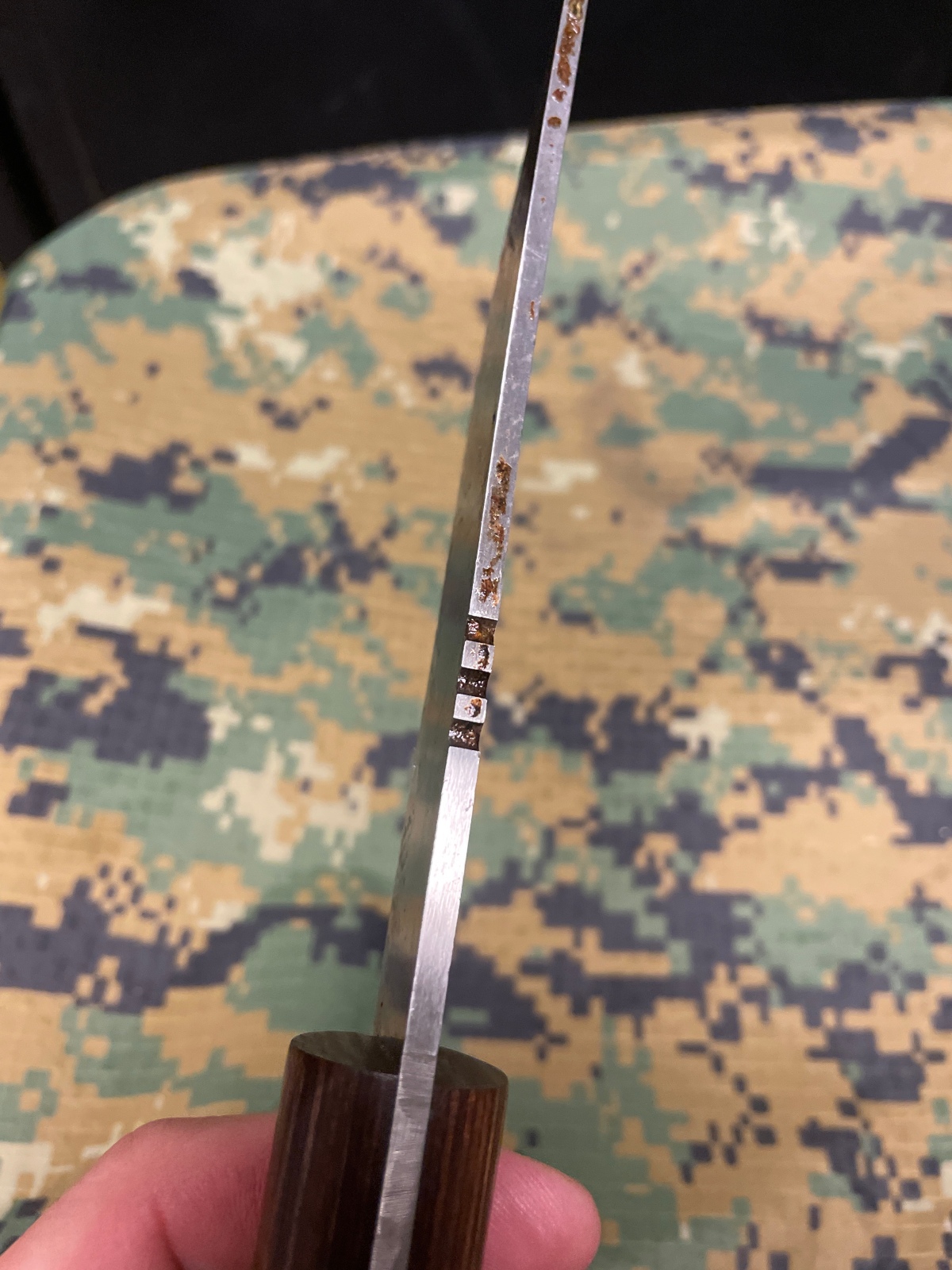
These are all skills we cover in The Fieldcraft Course, and if you’d like to learn very practical and effective methods of fire making I’d love to have you out.
After extensive use the spine can begin to lose its sharp corners, and through the course of striking with a rock it develops small cavities from the impacts. These can catch dirt and moisture, resulting in corrosion.
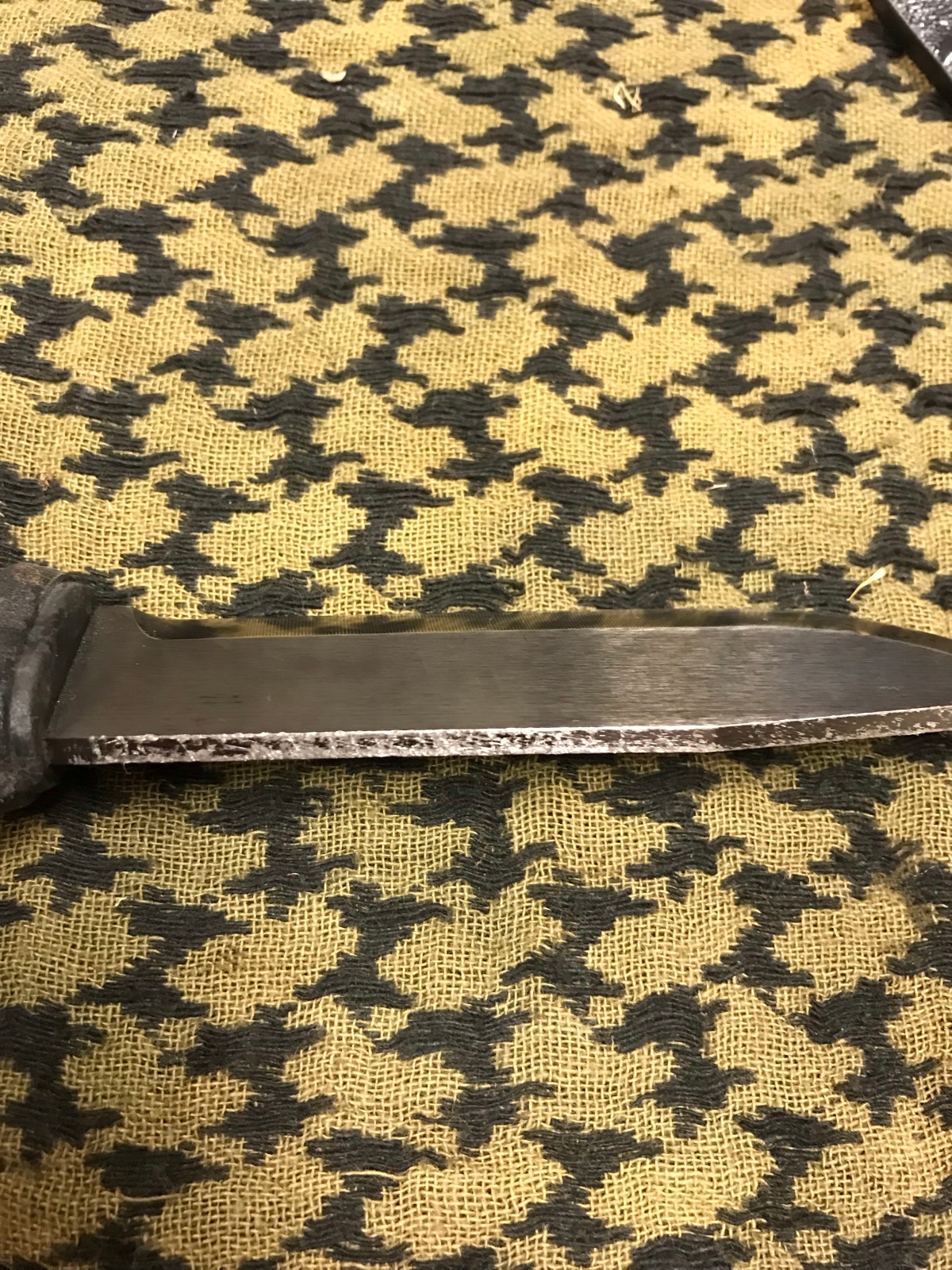
There’s a few different ways we can restore our spine, but the one I’ve found to work best for me uses a Smith’s two sided Diamond stone. You can also use a regular wet stone, the DC3, or a metal file, like the one on your multi-tool.

Remember how I said sharpening creates a burr on the blade? We can use this same fact to intentionally create a burr on the spine of our knife for scraping. This burr helps to get those nice big molten balls off our ferro rod when trying to start a fire.
The burr gets created in the opposite direction the blade is traveling on the stone. To make this easier to understand, think of it like the stone is smearing the metal as if it were slime.
To get the burr going in the right direction, we need to pull the knife the right direction. I’m right handed, so I hold the knife in my right hand, with the edge pointing up and the spine against the stone as square as I can hold it. I hold the stone with one hand, and starting at the bottom of the stone I scrape the blade towards the top.

I continue doing this and cleaning out the stone as needed. If I do it correctly, I’ll end up with a nice burr that will catch my finger nail on the left side of the spine. Once I have the burr created and most of the marks from using the knife as a fire steel are gone, I add a coat of coconut oil to the whole blade.

It’s at this point that I also remove any surface rust and clean the knife. I just use a rag with some coconut oil and scrub it off.
Sheath maintenance
Finally I move onto the sheath. As I said earlier, my sheath is Kydex. But it also has some leather components like the belt loop and the retention strap. These will need to be maintained with some oil or wax to keep them waterproof and to keep them from dry rotting.
I simply take a liberal amount of oil and work it into the leather portions by hand. If your sheath is all leather, do the same to the whole thing, making sure to put oil in the hard to reach places inside the sheath.
These leather components are attached to the kydex with Chicago screws. As with anything threaded, these can work loose over time. I have a basic rule of thumb – everything threaded gets torqued with locktite. For most things that don’t require extreme use, like these sheath screws, I use blue locktite.
My sheath also has a snap fastener, and I like make sure it’s clean and add a drop of oil inside the snap.

Next I inspect the cordage on the sheath to make sure it isn’t damaged and isn’t trying to come off.

I inspect the Gorilla tape I have on the belt loop. This is mainly there to close up the massive belt loop so it fits better on my belt, but it could also be used as a flame extender if needed.

Lastly I check to make sure the #14 sail needle I have wrapped up and tucked into the cordage is secure.
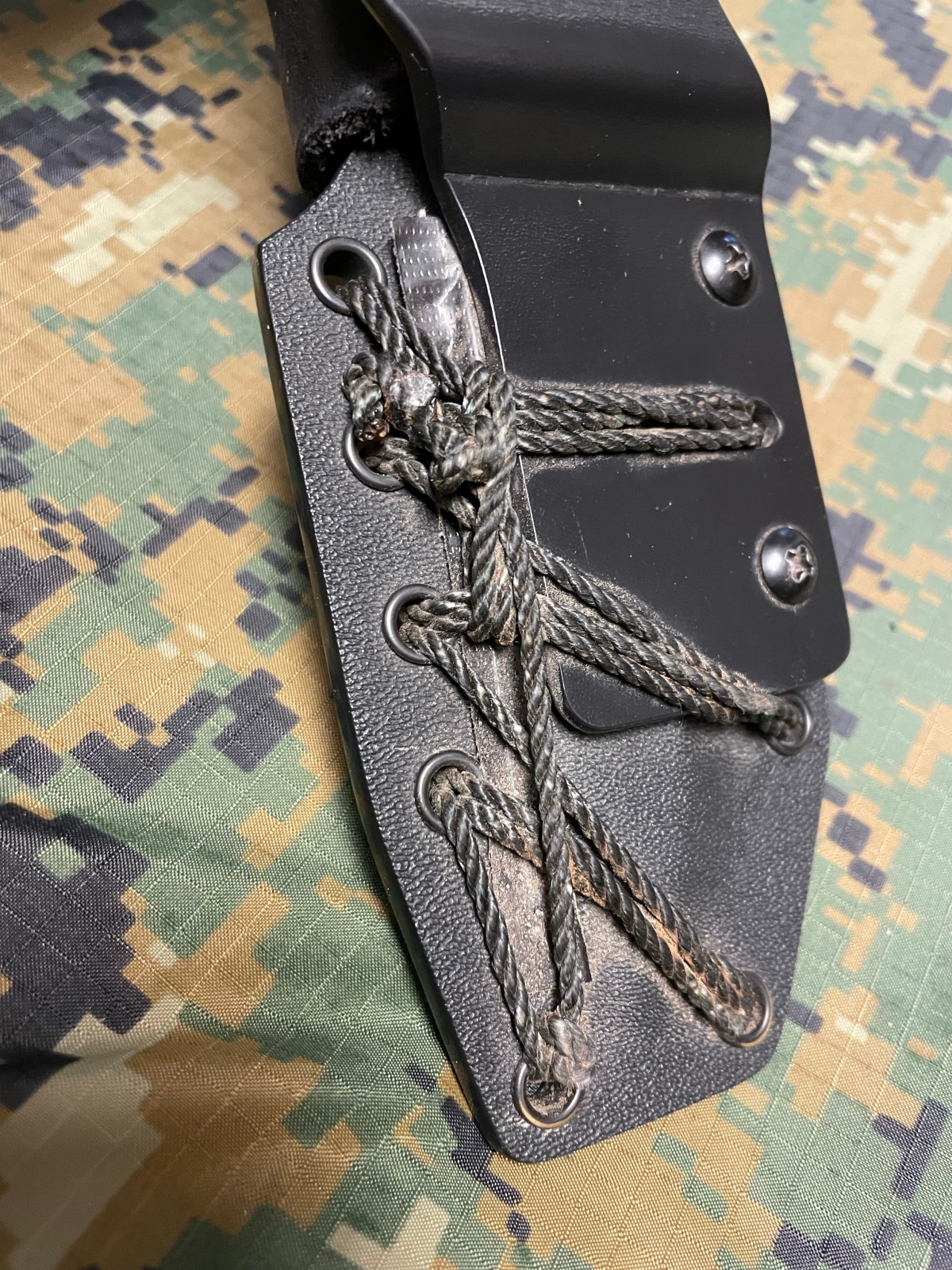
I finish the sheath maintenance by flushing the sheath out with water to remove any built up debris, then let it dry for a few days with the knife left out.
I’ve found this to be a simple and practical routine, done just as easy in the field as at home.
Share This Story, Choose Your Platform!
5 Comments
Comments are closed.




































Very good writeup….Thanks
Thank you and you’re welcome!
5
Descriptive article. I enjoyed it. It’s probably too small for a belt knife, however I find myself carrying the Morakniv Eldris more frequently as opposed to my Benchmade folder.
The Eldris is a nice knife. It is a little short for a belt knife I think too, but it’s a heck of a good knife to carry if you are already carrying a large knife.